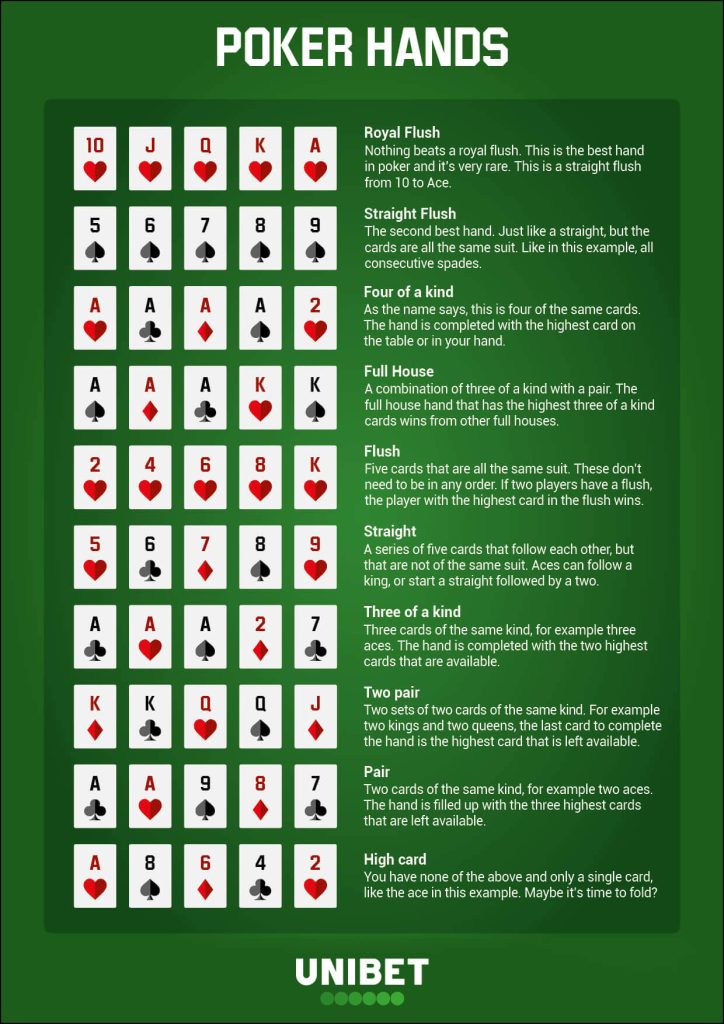Introduction:
In the dynamic world of poker, Texas Hold’em stands out as the quintessential card game that combines skill, strategy, and a touch of luck. Central to the mastery of Texas Hold’em are the various poker hands, each a unique combination of cards that can either lead to triumph or signal defeat. In this comprehensive exploration, we delve into the intricacies of poker hands texas holdem, unraveling the hierarchy, strategies, and psychological nuances that define this thrilling game.
Chapter 1: The Basics of Texas Hold’em
Texas Hold’em, the most popular variant of poker, is played with a standard 52-card deck. Each player is dealt two private cards (hole cards), and five community cards are placed face-up on the table. The objective is to create the best possible hand using a combination of the player’s own cards and the community cards.
The game unfolds in a series of betting rounds, with players strategically deciding whether to check, bet, raise, or fold based on the strength of their hand and their assessment of opponents’ potential hands. The climax of each hand is the showdown, where the remaining players reveal their cards, and the one with the highest-ranking hand claims the pot.
Chapter 2: Poker Hand Hierarchy
Understanding the hierarchy of poker hands is fundamental to success in Texas Hold’em. The ranking, from the highest to the lowest, is as follows:
- Royal Flush: A, K, Q, J, 10 of the same suit.
- Straight Flush: Five consecutive cards of the same suit.
- Four of a Kind: Four cards of the same rank.
- Full House: Three of a kind plus a pair.
- Flush: Five cards of the same suit, not in sequence.
- Straight: Five consecutive cards of different suits.
- Three of a Kind: Three cards of the same rank.
- Two Pair: Two sets of pairs.
- One Pair: A single pair of cards.
- High Card: If no one has any of the above, the hand is valued by the highest-ranking card.
Chapter 3: The Power of Starting Hands
Success in Texas Hold’em starts with the selection of starting hands. Experienced players understand that not all hands are created equal, and strategic decisions about which hands to play can significantly impact overall success. Starting hands can be broadly categorized into premium, strong, and marginal hands.
- Premium Hands: These are the most powerful starting hands, including pairs of aces, kings, queens, or ace-king (suited or not). Playing these hands aggressively is often recommended, as they have a high chance of winning.
- Strong Hands: Strong hands include high pairs like jacks or tens, as well as strong combinations like ace-queen or ace-jack. While not as powerful as premium hands, they still provide a good chance of success.
- Marginal Hands: Marginal hands require careful consideration. These include hands like small pairs, suited connectors, or one high card. Deciding whether to play these hands depends on various factors, including position, table dynamics, and opponents’ tendencies.
Chapter 4: Positional Awareness
In Texas Hold’em, the importance of positional awareness cannot be overstated. The dealer position, or “the button,” is considered the most advantageous as the player on the button acts last in each betting round. Players in later positions have more information about their opponents’ actions, allowing for more informed decisions.
Smart players exploit their position, playing more hands when in a late position and adopting a tighter strategy when in an early position. Understanding the dynamics of position enhances a player’s ability to control the flow of the game and capitalize on strategic opportunities.
Chapter 5: Post-Flop Strategy
Once the first three community cards (the flop) are revealed, players must adapt their strategies based on the evolving possibilities. Post-flop play involves assessing the strength of one’s hand, predicting opponents’ likely holdings, and making strategic decisions accordingly.
- Continuation Betting: Following up a pre-flop raise with a bet on the flop is known as a continuation bet. It allows the initial aggressor to maintain control of the hand and puts pressure on opponents.
- Drawing Hands: If a player has a drawing hand (a hand that needs additional cards to improve, like a flush or straight draw), post-flop is the time to assess the odds of completing the draw versus the potential payoff.
- Reading Opponents: Skilled players pay close attention to opponents’ actions, betting patterns, and behavior to glean insights into the strength of their hands. Adaptability and the ability to read opponents are key components of successful post-flop play.
Chapter 6: The Turn and the River
The fourth and fifth community cards, known as the turn and the river, respectively, complete the board. These cards can dramatically alter the course of the hand and often lead to significant betting activity.
- Double-Barreling: If a player initiated a continuation bet on the flop, following up with another bet on the turn (double-barreling) can further apply pressure on opponents and solidify control of the hand.
- Value Betting: As the hand progresses, players must assess the value of their hand relative to the community cards. Making well-timed value bets can extract chips from opponents with weaker holdings.
- Bluffing: The turn and river are common stages for strategic bluffing. Skilled players use their understanding of opponents’ likely hands to execute well-timed bluffs, representing strength when holding a weaker hand.
Chapter 7: The Art of the Bluff
Bluffing is a hallmark of poker strategy, and in Texas Hold’em, mastering the art of the bluff is a skill that sets apart the exceptional players. A successful bluff involves convincing opponents that a player holds a stronger hand than they actually do, prompting them to fold superior hands.
- Choosing the Right Moment: Effective bluffing requires careful timing. Choosing the right moment, often when the community cards create a plausible narrative for a strong hand, increases the likelihood of a successful bluff.
- Reading Opponents: Bluffing is a two-way street. Skilled players not only execute well-timed bluffs but also read opponents to identify potential bluffs. A keen understanding of opponents’ tendencies and betting patterns is crucial in both bluffing and detecting bluffs.
- Balancing the Bluff: A successful poker player strikes a delicate balance between bluffing and playing strong hands straightforwardly. Over-reliance on bluffing can make a player predictable, while never bluffing can lead to missed opportunities.
Chapter 8: Psychological Aspects of Texas Hold’em
Beyond the mathematical and strategic aspects, Texas Hold’em is a game of psychology. The ability to read opponents, disguise one’s intentions, and maintain a stoic demeanor are essential elements of a winning mindset.
- Poker Face: A “poker face” is the ability to conceal emotions and intentions, preventing opponents from gaining insights into the strength or weakness of a player’s hand. Maintaining composure under pressure is a crucial aspect of poker psychology.
- Tells: Physical and behavioral cues, known as “tells,” can inadvertently reveal information about a player’s hand. Observant players learn to identify and exploit these tells, gaining a psychological edge over opponents.
- Table Image: A player’s table image, cultivated through consistent gameplay and betting patterns, influences how opponents perceive their style of play. A strategic player can manipulate their table image to their advantage, fostering uncertainty among opponents.
Chapter 9: Tournament Strategy
Tournaments introduce an additional layer of complexity to Texas Hold’em. Unlike cash games, where chips represent real money, tournaments have escalating blind levels that increase the pressure on players. Survival and accumulating chips become paramount objectives.
- Adjusting to Blind Levels: As blinds increase, players must adjust their strategies to avoid being blinded out. This often involves becoming more aggressive, seeking opportunities to accumulate chips, and avoiding overly conservative play.
- Paying Attention to Stack Size: A player’s stack size relative to the blinds influences their strategic options. Deep stacks afford more flexibility, allowing for calculated plays, while short stacks may necessitate riskier decisions to avoid elimination.
- Changing Dynamics: As players are eliminated, table dynamics shift. Paying attention to the changing composition of the table and adapting strategies accordingly is crucial for tournament success.
Chapter 10: Continuous Learning and Adaptation
In the ever-evolving landscape of Texas Hold’em, continuous learning is a hallmark of successful players. Keeping abreast of emerging strategies, studying opponents, and analyzing hand histories contribute to ongoing improvement.
- Hand Analysis: Reviewing and analyzing played hands, whether individually or through peer discussion, provides valuable insights into strategic decisions and identifies areas for improvement.
- Staying Informed: The poker landscape evolves with emerging trends, strategies, and technologies. Staying informed through poker literature, online forums, and participation in the poker community ensures players remain at the forefront of the game.
- Bankroll Management: Responsible bankroll management is integral to long-term success. Players must be disciplined in managing their poker funds, avoiding excessive risk and ensuring sustainability over the course of their poker journey.
Conclusion:
Mastering the art of poker hands texas holdem is a journey that combines mathematical acumen, strategic finesse, psychological insight, and an unyielding commitment to continuous improvement. From the initial selection of starting hands to the climactic showdown, every decision in Texas Hold’em is an opportunity for skillful execution and strategic brilliance. As players navigate the complex web of community cards, betting rounds, and opponents’ behaviors, the allure of Texas Hold’em lies in its capacity to challenge, captivate, and reward those who embark on the quest for mastery. Whether at a casual home game or a high-stakes tournament, the dynamics of Texas Hold’em poker hands promise an ever-evolving adventure for enthusiasts and professionals alike.

